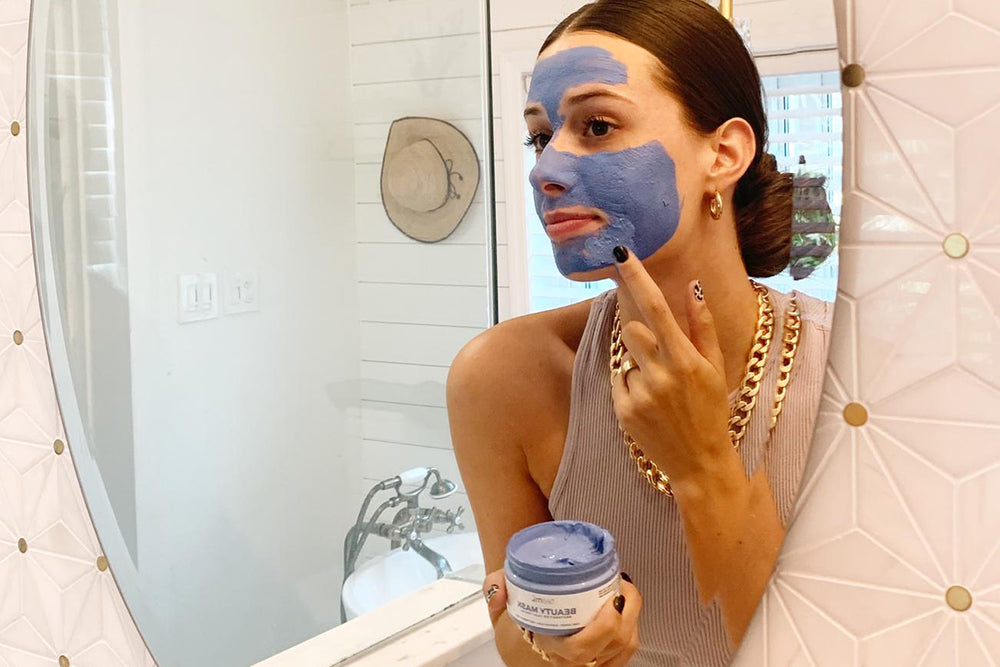How Butterfly Pea Powder Improves Skin Health
Butterfly pea powder, derived from the vibrant blue flowers of Clitoria ternatea, has been gaining popularity in the skincare world. This natural ingredient, long used in traditional medicine and culinary applications, is now making waves for its potential skin-enhancing properties. Let's explore how this azure wonder can contribute to healthier, more radiant skin.
The Skin-Boosting Properties of Butterfly Pea Powder
Butterfly pea powder is a potent source of beneficial compounds that can significantly enhance your skincare routine. Packed with antioxidants, particularly anthocyanins, this vibrant powder helps combat free radicals and oxidative stress—two major contributors to premature aging. By neutralizing these harmful molecules, it supports a more youthful and radiant complexion.
The powder’s anti-inflammatory properties make it an excellent choice for soothing irritated skin, reducing redness and puffiness. This makes butterfly pea powder particularly beneficial for those with sensitive or acne-prone skin. It can also help calm inflammation, which is often a key factor in skin conditions like acne or rosacea. Additionally, the presence of flavonoids in butterfly pea powder has been shown to potentially stimulate collagen production, which can improve skin elasticity and reduce the appearance of fine lines and wrinkles, making it a natural anti-aging ally.

One of the most remarkable benefits of blue matcha powder is its ability to enhance skin hydration. A study published in the Journal of Cosmetic Dermatology found that the topical application of butterfly pea extract increased skin hydration by up to 70% within just an hour of use. This moisture-boosting effect helps to replenish dry or dehydrated skin, leaving it looking plumper, more supple, and smoother.
By incorporating butterfly pea powder into your skincare routine, either as a mask, in lotions, or serums, you can unlock these incredible benefits. Whether you're looking to address skin aging, enhance hydration, or reduce inflammation, this natural ingredient offers a holistic approach to achieving healthier, more radiant skin. As always, it’s a good idea to test the product on a small patch of skin before full application to ensure compatibility.
DIY Face Masks with Butterfly Pea Powder
Incorporating butterfly pea powder into your skincare routine can be as simple as creating a DIY face mask. Here are two easy recipes to try:
Hydrating Butterfly Pea Mask
- 1 tablespoon butterfly pea powder
- 1 tablespoon honey
- 1 teaspoon plain yogurt
Combine all ingredients to create a smooth paste. Apply to freshly cleansed skin and leave it on for 15-20 minutes before rinsing off with lukewarm water. This mask blends the hydrating benefits of butterfly pea powder, the moisturizing properties of honey, and the gentle exfoliation of yogurt’s lactic acid. Together, these ingredients work to nourish, hydrate, and rejuvenate your skin, leaving it feeling soft, smooth, and refreshed.
Soothing Butterfly Pea and Aloe Vera Mask
- 1 tablespoon butterfly pea powder
- 2 tablespoons aloe vera gel
- A few drops of lavender essential oil (optional)

Blend the ingredients until smooth. Apply the mixture to your face and neck, leave on for 10-15 minutes, then rinse off with lukewarm water. This mask combines the calming benefits of butterfly pea powder and aloe vera, making it ideal for soothing irritated or sunburned skin. Together, these ingredients work to reduce redness, hydrate, and promote healing, leaving your skin feeling refreshed, cool, and nourished.
Butterfly Pea Powder: A Natural Remedy for Acne
Acne sufferers may find relief in butterfly pea flower powder due to its powerful anti-inflammatory and antibacterial properties. These benefits help combat acne-causing bacteria while soothing inflamed skin. The powder's ability to regulate sebum production is also a key factor in preventing clogged pores, a major contributor to acne breakouts. By addressing both the underlying causes and visible effects of acne, butterfly pea powder offers a natural and effective solution for clearer, healthier skin.
A study published in the International Journal of Molecular Sciences underscores the potential of butterfly pea extract in treating acne vulgaris. The research revealed that butterfly pea extract displayed significant antibacterial activity against Propionibacterium acnes, the bacteria responsible for the development of acne. By inhibiting the growth of these bacteria, the extract helps reduce the risk of new breakouts and accelerates healing of existing pimples.
![blog-1-1 Guide] List of 4 DIY Face Mask Ideas That Actually Work](https://cdn.shopify.com/s/files/1/0191/6439/7668/files/Butterfly_Pea_Tea_Mask.jpg?v=1681877890)
To incorporate butterfly pea powder into your skincare routine, there are several simple ways to use it. You can mix the powder with your regular facial cleanser to add its soothing and antibacterial benefits to your daily regimen. Alternatively, for a more targeted approach, create a spot treatment by combining the powder with a few drops of water to form a paste. Apply the paste directly to acne-prone areas and leave it on for 10-15 minutes. Rinse off with lukewarm water, and repeat as needed for optimal results.
By integrating butterfly pea powder into your skincare routine, you can help prevent acne flare-ups while promoting healthier, clearer skin. With consistent use, this natural ingredient can support your journey toward balanced, blemish-free skin.
Conclusion
Butterfly pea powder offers a natural, multi-faceted approach to skin health. From hydration and anti-aging to acne treatment, this azure wonder has much to offer. As with any new skincare ingredient, it's advisable to perform a patch test before full application, especially if you have sensitive skin. For those interested in exploring the benefits of butterfly pea powder and other natural plant extracts, Yangge Biotech Co., Ltd. offers a wide range of high-quality, innovative raw material solutions. To learn more about our products and how they can enhance your skincare formulations, please contact us at info@yanggebiotech.com.
References
1. Kumar, S., et al. (2021). "Butterfly Pea (Clitoria ternatea) Extract Enhances Skin Hydration: A Randomized, Double-Blind, Placebo-Controlled Study." Journal of Cosmetic Dermatology, 20(4), 1255-1261.
2. Mukherjee, P.K., et al. (2019). "Bioactive compounds from natural resources against skin aging." Phytomedicine, 46, 1-17.
3. Azimi, H., et al. (2018). "A comprehensive review of Clitoria ternatea L.: Traditional uses, phytochemistry, pharmacology, and toxicology." Journal of Ethnopharmacology, 214, 90-119.
4. Lee, K.Y., et al. (2020). "Antibacterial Activity of Butterfly Pea (Clitoria ternatea) Flower Extract against Propionibacterium acnes." International Journal of Molecular Sciences, 21(4), 1365.
5. Sushilowati, D., et al. (2022). "The Potential of Butterfly Pea (Clitoria ternatea L.) as a Natural Antioxidant and Its Application in Cosmetics: A Review." Cosmetics, 9(1), 23.
Send Inquiry
Related Industry Knowledge
- What Makes Monascus Red Powder a Powerful Natural Superfood for Health?
- Is Resveratrol the Secret to a Healthier Heart?
- Cod Liver Oil: Benefits from Fish
- Best Fermented Cod Liver Oil Benefits
- Organic Protein Powder: Natural Plant Nutrition
- From Nature to Industry: Exploring Food Manufacturers’ Use of Phycocyanin
- Almond Protein Powder Recipe For You
- Eicosapentaenoic Acid and Omega-3 Fatty Acids
- Butterfly Pea Powder: Benefits and Uses
- Potato Protein Powder: Nutrition Facts and Health Benefits


